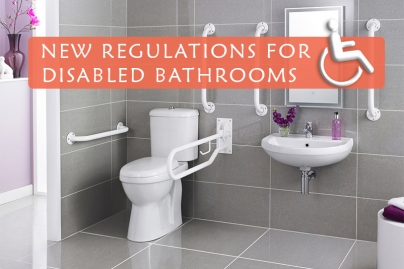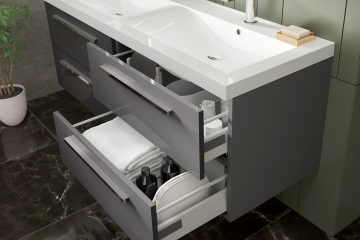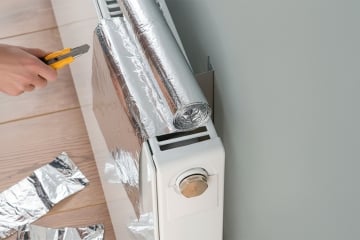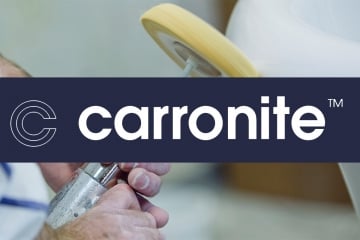New Regulations for Disabled Bathrooms

New Regulations for Disabled Bathrooms
It is essential that every effort is made to ensure that people are able to find usable bathroom facilities, wherever they go and whatever their physical handicaps. Since the introduction of the Equality Act 2010 and the Care Act in 2014, organisations have been obligated to provide accessible utilities for their employees and customers. One of the most important aspects of this is ensuring that toilet and bathroom facilities are available to every visitor, regardless of their physical capabilities. There are a number of different requirements that an accessible property needs to fulfil and this article will detail some of the new regulations for disabled bathrooms.
An accessible bathroom needs to be suitable for use by the majority of independent wheelchair users and will provide enough space for a carer if necessary. In addition, it should meet the requirements of users with health conditions that affect their bathroom usage, such as those with bladder or bowel issues. Grab rails and emergency alarms are also required, in order to make the toilet usable for as many people as possible. While it's unreasonable (and almost impossible) to expect every business owner to be able to offer a toilet that is usable by every person, regardless of their physical capabilities, they have a responsibility to make their facilities as accessible to as many people as possible. There are certain requirements that must be met in order to do this.
Types of Bathroom
There are two specific types of accessible bathrooms: accessible and ambulant accessible. It is important to recognise the differences between (and requirements of) these two types before installing your toilet.
Ambulant accessible toilets are the most widespread disabled toilets and the most straightforward to install. Ambulant accessible toilet cubicles tend to be a similar size to those of standard toilets, meaning they are often installed as part of a larger public bathroom alongside other toilets. They will have higher toilet pans and grab rails to allow for easier sitting and standing, and an outward opening door where possible. These toilets do not offer access for wheelchairs or facilities for users with colostomy bags.
True accessible toilets are more extensive conversions but are able to be used by people with a far wider range of special requirements. They feature the same utilities as an ambulant toilet (a higher toilet pan and grab rails) but also include wheelchair accessibility, shelves for colostomy and wash basins designed for use by people with limited hand dexterity. These wash basins will feature lever taps or, thanks to the benefits of modern technology, sensor taps that activate automatically when hands are placed under them. Emergency alarms, which are advisable in any disabled toilet, must be installed for a bathroom to be considered truly accessible. Doors must open outwards and be at least 900mm wide to allow for easy wheelchair access. These doorways needn't be any higher than a standard door (900mm is also a standard width). Due to requiring space for a wheelchair, accessible toilets need more floor space (1500mm x 2200mm). In most cases, accessible toilets will be configured for right handed wheelchair transfer but in locations with more than one, this should alternate from toilet to toilet.
Accessible Bathroom Requirements
Regulations must be complied with when installing new bathrooms, whether in a new build, an extension or a refurbishment. This includes when an existing bathroom is refitted to be accessible. There are other important guidelines to consider when installing an accessible toilet. This list is not complete but describes some of the main things to consider when installing an accessible bathroom:
- In addition to any disabled cubicles in public male or female toilets, it is important that there is a separate unisex bathroom that is accessible without needing to pass through these single gender rooms. This is to ensure that disabled users can be accompanied to the bathroom by someone of a different gender, if needed.
- Accessible toilets should be kept clear of any unnecessary clutter; they should not be used as storage for cleaning products or other items due to the importance of clear access.
- Door locks, taps and shower controls should be easily operated without the need to clench or grip a handle, allowing users with limited dexterity to enjoy privacy and independence while using the bathroom. This will usually come in the form of lever operation, or sometimes push button models.
- Lighting should not be triggered by motion alone, as users with limited mobility may be unable to activate the lights again if they turn off.
- Taps and showers should be thermostatically controlled to ensure that users don't burn themselves while manipulating the controls. This is especially true of users with diminished sensitivity, who might be scalded without being aware of the water temperature.
- Cleaning staff should be trained to ensure they are aware of the specific requirements of accessible bathrooms. These include ensuring that cistern tops, shelves and transfer zones are kept clear and that alarm pull cords should never be tied up and made unreachable from the toilet.
- Accessible toilets with wheelchair access should not be expected to also serve as a baby changing area. It is vital that they are kept clear for their intended users and having the room perform two roles can double the frequency with which it is occupied.
- Grab rails need to be configured in a certain layout to comply with Document M. It is possible to buy "Doc M" packs, which will include the rails and instructions necessary to install a compliant toilet. These rails will also need to be a distinct colour from the walls they are fitted to, usually blue or dark grey rails on white walls or white rails on darker walls. This is in order to ensure that these rails are sufficiently visible for people with impaired vision. White rails should not be used in rooms with white paint or tiles as there will be insufficient contrast between them. Similar guidance exists for disabled showers, with "Doc M" packs offering a straightforward way of installing a compliant shower.
- Unnecessary furniture such as vanity units, or alterations such as boxing in of pipes, should be avoided as they reduce floor space and can make it more difficult for wheelchair users to access wash basins. If you design your accessible toilet to be used by able-bodied users as well as disabled, you will need to add a standing height wash basin as well and increase the room size to 2000mm x 2200mm to accommodate this.
- Accessible showers will need to allow space for wheelchair access and transfer, as well as featuring the necessary seat and grab rails to make this possible for the majority of users. An accessible shower room needs to be at least 2200mm x 2000mm, with this expanding to 2500mm x 2400mm if a corner toilet is also included. If a disabled shower is part of a larger showering area, such as accompanying a public swimming pool, it is important to provide a number of lockers that can hold special items such as crutches.
- If maintenance, decoration or refurbishment is going to make an accessible toilet unusable and there are no alternate facilities in the same location, it is important to inform users in advance. These details need to include how long people will be unable to use the toilet facility, where the nearest alternative is and how quickly and easily it can be reached. Due to the importance of accessible toilets for disabled visitors and how detailed their travel plans might be, advanced warning and detailed advice are both highly beneficial. This information can be relayed in a variety of ways: company apps, website updates, social media posts, bulletin boards, audio or video announcements on the premises or simple face to face communication.
For a complete list of the requirements of an accessible bathroom, both for users with limited dexterity and wheelchair users, the UK government's Document M can be found here. The advice in this article forms a guideline for installing an accessible toilet and some of the chief concerns to keep in mind; if you are unsure of any requirements it's best to seek advice from your local building authority or a professional accessibility organisation.
Related Posts
Vanity units take constant abuse from water, humidity, cleaning products, and daily wear. Choose the wrong material and you're replacing it within five years, whilst the right choice lasts decades.
Radiator reflectors promise to boost your heating efficiency and reduce energy bills by reflecting heat back into the room instead of letting it escape through the wall. Sounds brilliant, but do they actually deliver?
The patented, triple-layer Carronite reinforcement system has been a staple in the bath industry for 40 years. We dig into the truth behind the strapline...




